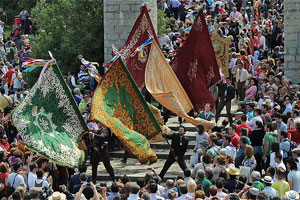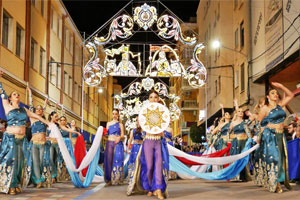Holly Week in Cartagena

Why visit the Holy Week of Cartagena
The Holy Week of Cartagena is one of the most important religious celebrations in Spain and is distinguished by several elements that make it unique and different from other Spanish Holy Weeks. Some of the most outstanding elements are:
Discipline and solemnity: One of the most notable characteristics of the Holy Week processions in Cartagena is the order and discipline of the penitents, who march to the sound of the drums in perfect synchronization. During the processions, the penitents walk and stop simultaneously, remaining motionless at the stops. In addition to order, other distinctive elements of the Holy Week of Cartagena are flowers, lights, and music.
"Los Californios" processions: One of the main features of the Holy Week of Cartagena is the presence of the "Los Californios" brotherhood, who parade in the processions dressed in costumes from the time of Spanish colonization in California.
The Marraja brotherhood: This brotherhood is unique in the world and is responsible for the procession of Holy Tuesday in honor of the Virgin of Piedad. The members of the brotherhood wear fishermen's clothes and carry the image of the Virgin on a boat that is carried on their shoulders.
The procession of Silence: On Holy Thursday, the procession of Silence takes place, where the members of the brotherhood parade in complete silence, without music or chants, in a sober and austere atmosphere.
The sculptures: The Holy Week of Cartagena has some of the best sculptures in Spain. It includes works by important Spanish sculptors such as José Capuz, José Sánchez Lozano, Juan González Moreno, Mariano Benlliure, Francisco Salzillo, and Federico Coullaut-Valera, among others. Also noteworthy are the embroidered mantles and standards, some of which date back to the eighteenth and nineteenth centuries.
The music: The Holy Week of Cartagena has its own musical repertoire, which includes processional marches composed especially for this celebration.
The importance of theater: The Holy Week of Cartagena is not only a religious celebration but also a cultural one. During the week, different theatrical performances are held in which moments of the Passion of Christ are recreated.
Undoubtedly, it is one of the most important religious celebrations in Spain and attracts thousands of tourists every year.
Origin and History
The Holy Week of Cartagena has a long history that dates back to the Middle Ages. The tradition of processions and brotherhoods was established in Cartagena in the sixteenth century, when the first brotherhood, that of the True Cross, was founded in 1579.
In the seventeenth century, the Holy Week of Cartagena gained great importance thanks to the impetus of the Carmelite Order, who promoted the organization of new brotherhoods and the creation of important religious images. During this century, the current sanctuary of Christ of Socorro was built, one of the most revered images of the Holy Week of Cartagena.
In the eighteenth and nineteenth centuries, the Holy Week of Cartagena continued to grow and consolidated as one of the most important religious celebrations in Spain. During this period, important religious buildings were constructed, such as the Church of Santa María de Gracia and the Church of San Ginés de la Jara.
Today, the Holy Week of Cartagena remains a deeply-rooted celebration in the city, which has a unique artistic and cultural heritage. In 2005, it was declared a Festival of International Tourist Interest and in 2019 it was declared Intangible Cultural Heritage of Humanity by UNESCO, demonstrating the importance and significance of this celebration.
In summary, the Holy Week in Cartagena has a long history dating back to the Middle Ages and has been developing and enriching over time. Nowadays, it is one of the most important religious celebrations in Spain and boasts a valuable artistic and cultural heritage.
What to see in Cartagena
Cartagena is a city with a rich history and cultural heritage, therefore it has numerous places of tourist interest. Below are some of the places you can visit in Cartagena:
- Roman Theatre: This theatre was built in the 1st century BC and is one of the most important Roman monuments in Spain. It was discovered in 1988 and has a capacity for 6,000 people.
- Castillo de la Concepción: This castle was built in the 13th century and is located on top of a hill overlooking the city. It offers spectacular views of Cartagena and has a museum dedicated to the history of the city.
- Barrio del Foro Romano: This neighborhood is located next to the Roman Theatre and has important Roman archaeological remains, such as the baths and the atrium of the temple.
- Municipal Archaeological Museum: This museum has a wide collection of objects and archaeological remains ranging from prehistory to the Roman era.
- Naval Museum: This museum is dedicated to the history of the Spanish Navy and has a wide collection of ship models, uniforms, and weapons.
- Consistorial Palace: This 19th century building is the seat of the Cartagena City Council and has an impressive neoclassical façade.
- Port of Cartagena: This port is one of the most important in Spain and has a rich history. In its surroundings, you can find numerous restaurants and bars where you can enjoy local gastronomy.
Cartagena is a city full of interesting places and historical monuments that are worth visiting. In addition, it has a wide cultural and gastronomic offer that makes it a destination of great value, added to the reason for its precious Holy Week.
What to eat in Cartagena
The gastronomy of Cartagena is varied and rich in flavors and typical dishes that reflect the influence of Mediterranean culture and the culinary tradition of the Region of Murcia. Some of the most popular dishes of Cartagena's gastronomy are:
- Caldero: A typical dish from the Mar Menor area, made with rice, rock fish, garlic, ñoras (a type of dried pepper), and spices.
- Rice and Lobster: A rice dish made with fresh lobster, onion, pepper, and tomato, which gives it an intense and delicious flavor.
- Migas: A traditional dish from the Murcian cuisine, made with bread, olive oil, garlic, pepper, and bacon, among other ingredients. In some regions of Murcia, you can even find some fruits in this dish.
- Murcian Salad: A fresh and tasty salad made with tomato, onion, tuna, hard-boiled egg, and olives.
- Paparajotes: A typical dessert from the Cartagena area, made with lemon tree leaves coated in a mixture of flour, egg, and milk, fried and served with sugar and cinnamon.
- Olla Gitana: A dish made with legumes, vegetables, and meat, very popular in the Region of Murcia, which is cooked slowly in a clay pot.
- Murcian Meat Pie: A typical dish from Murcian cuisine, made with minced meat, egg, onion, pepper, and spices, baked in puff pastry.
Cartagena offers a wide variety of dishes and flavors, with a great influence from Mediterranean culture and the culinary tradition of the Region of Murcia. It's very easy to discover them in its bars and restaurants while strolling through the center.





